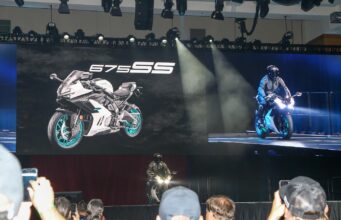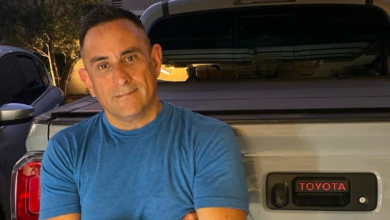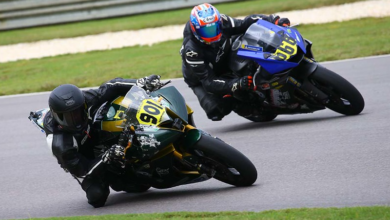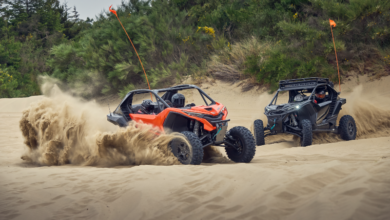Aug. 10, 2009 – Honda shifts more to 100 mpg vs. 200hp
By Neil Pascale
Editor
Ray Blank, senior vice president of American Honda Corp.’s Motorcycle Division, has been with the corporation for more than 20 years. But chances are the past few years have been the most dramatic in terms of U.S. market shifts.
Not only in terms of retail sales but consumer appetite and the company’s corresponding attempt at fulfilling those desires. “More and more today that’s less in the vision of 200hp and more in the vision of 100 mpg,” Blank said of consumer wants and the company’s R&D efforts.
In an exclusive interview with Powersports Business, Blank addressed not only the company’s changing R&D focus, but its view of the U.S. and worldwide powersports markets and how alternative-fuel vehicles could play a role in those arenas. Blank also discussed what, if any, impacts the company’s recent reorganization has had on its dealer services. He also touched on Honda’s interest in the UTV market, a large off-road category that the manufacturer has entered thus far in a relatively small way.
But mostly, Blank discussed the shifting U.S. marketplace and how Honda is reacting to those changes. “Less than 1,000 days ago you couldn’t have given away some of the bikes that are the hottest sellers right now,” he said in reference to the changing U.S. consumer appetite.
Some of those hot sellers have proved to be effective because of their perceived low-cost transportation benefit rather than any recreational allure they might possess. Blank says Honda has adapted to this dramatic consumer shift by adding to its smaller-displacement, mpg-friendly vehicles. That includes the SH150i, the No. 1 selling scooter in Italy that was homologated for the United States for Honda’s 2010 lineup, and a soon-to-be-announced vehicle from Asia that will possess similar market qualities.
“We realize this market is changing,” Blank said. “What is it people are going to want in this economy? Are they going to want more fuel-efficient vehicles?
“It wasn’t too long ago that no one cared. No one really cared what motorcycle mpg was. Now you see every maker out there hanging a hangtag on (a motorcycle) that says, ‘We’re getting
40 mpg’ or something like that. Well we’re directing development more into areas of public concerns, and we’re putting more resources behind that. We’re in a very good position to do that because it’s been a part of what the company has been about for a long time.”
Honda has a history of introducing some of its new technology through its motorcycle division, including its turbo-charged engines that started on the two-wheel platform in the early 1980s before eventually crossing over to the auto side. Will alternative-energy power plants follow suit? And if that happens, could such technology debut in the North American market?
While there are no concrete answers for either of those questions yet, Honda has certainly made alternative-fuel headlines with its Clarity, a hydrogen fuel cell car that has reached the?U.S. market.
“While (Honda’s motorcycle division) won’t necessarily be first with alternative fuel approaches, we probably are best equipped to be making alternative fuel considerations within the world of motorcycles,” Blank said.
The economics
When Honda does bring its alternative fuel technology to the motorcycle side, economics will prove crucial in terms of where it will appear first, Blank believes.
“You look at countries like Thailand, the Philippines, Cambodia, India and you’re talking about markets that are 3 million units a year, 2 million units a year,” Blank said. “If you get in there and make a 5 percent application of an alternative fuel vehicle, you’re talking about tremendous numbers.”
The type of numbers that could dramatically lower manufacturing costs on a per unit basis.
“If we did introduce it in one of those markets first,” Blank said of alternative-fuel powersports vehicles, “and it became a reasonably successful product, bringing it over here (to North America) would be pretty easy.”
Regardless of where it is introduced and on what platform, it’s clear Honda is intent on developing alternative-fuel technology. Blank called the effort at introducing environmentally friendly products “part of the DNA of Honda and as such there is constant behind-the-scene development for considerations like that.
“For future generations, certainly much more so than my generation, there is a real concern about what’s happening globally with regard to the use of fossil fuel and all the other things going on from an environmental standpoint and there is true interest in alternative fuels.”
Could the downturn in the United States and other global markets cause that alternative-fuel technology to be delayed? After all, Honda has not been immune to the industry’s struggles in 2009. Earlier this year, Honda reported a 29 percent decline for its North American motorcycle segment new unit sales — that includes motorcycles, ATVs and PWC — and that percentage could increase as the industry as a whole has declined more than 40 percent in the first half of 2009 in terms of new unit sales.
“It is the perfect storm, but Honda is in a better position than most and a big part of that is due to the motorcycle business,” Blank said, noting the company has seen sales increases in some of its key worldwide markets. “Now if you look at the domestic motorcycle business, well you’re not going to see that. But that’s why you have to take a look at these markets with a different eye.”
Blank doesn’t dismiss the significant downturns in the traditional large-displacement bike business, but notes a big part of the industry — the utility side — is still healthy.
“The way we’re looking at the market right now is the ATV market is still a very viable utility and recreational market,” he said, “recreational side being stunted a bit by the economy but the utility side, it’s still going pretty strong. It really is.”
Blank and Honda also remain optimistic about the long-term viability of the UTV market, a relatively young segment that has been a growing part of the industry for the past several years.
“This is an emerging category,” he said. “It’s starting to define itself. We’re starting to see the places where everything is going and yeah, we’re definitely interested in it.”
Honda did introduce a side-by-side for its 2009 lineup, the Big Red, but in the very early going it has yet to capture the kind of market share the company’s ATV lineup has. By retail sales estimates provided to Powersports Business, Honda not only remains the U.S. market share leader in ATVs, but grew its market share last year. Blank would not say whether Honda is seeking to become just as large a player in the UTV market but he did note, “We expect this will be a category where we’ll be a player.”
‘Refocusing the business’
Blank also addressed Honda’s recent reorganization within its powersports division. The reorganization included the departure of at least 60 Honda associates as part of a voluntary separation program.
“We are not reducing any services to the dealer,” Blank said of the impact of the reorganization, noting, “dealers are the reason why American Honda is here.
“What we’re doing is refocusing the
business to make sure that we’re 100 percent focused on the highest, most critical needs
that the dealer has.”
Those include distribution, product development and the day-to-day business operations. Honda has cut back on marketing, including advertising and staff in certain consumer services like the Honda Riders Club. The company also withdrew from pro racing in the form of Team Honda, although Honda still provides support mechanisms for racing teams.
“What we’ve had to is cut back on the nice-to-haves and bolstered the must-haves,” Blank said.
The latter category, Blank said, certainly includes R&D and meeting the demands of the environmentally conscious consumer.
“I don’t think anybody would argue that Honda is in the best position to do that,” Blank said.





